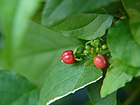Note: This is a project under development. The articles on this wiki are just being initiated and broadly incomplete. You can Help creating new pages.
Rivina Humilis
Rivina Humilis is a herbaceous perennial plant growing from a woody taproot and with stems that are somewhat woody at the base. The red fruits are gathered from the wild to be used for dyeing. The plant is widely grown as an ornamental in the tropics and subtropics, where it is particularly valued for its brilliantly coloured, rather handsome berries.
Contents
[hide]- 1 Uses
- 2 Parts Used
- 3 Chemical Composition
- 4 Common names
- 5 Properties
- 6 Habit
- 7 Identification
- 8 List of Ayurvedic medicine in which the herb is used
- 9 Where to get the saplings
- 10 Mode of Propagation
- 11 How to plant/cultivate
- 12 Commonly seen growing in areas
- 13 Photo Gallery
- 14 References
- 15 External Links
Uses
Parts Used
Leaf.
Chemical Composition
Common names
| Language | Common name |
|---|---|
| Kannada | |
| Hindi | |
| Malayalam | |
| Tamil | |
| Telugu | |
| Marathi | |
| Gujarathi | |
| Punjabi | |
| Kashmiri | |
| Sanskrit | |
| English | Areca nut |
Properties
Reference: Dravya - Substance, Rasa - Taste, Guna - Qualities, Veerya - Potency, Vipaka - Post-digesion effect, Karma - Pharmacological activity, Prabhava - Therepeutics.
Dravya
Rasa
Guna
Veerya
Vipaka
Karma
Prabhava
Habit
Identification
Leaf
| Kind | Shape | Feature |
|---|---|---|
Flower
| Type | Size | Color and composition | Stamen | More information |
|---|---|---|---|---|
| Flowering season is November-August |
Fruit
| Type | Size | Mass | Appearance | Seeds | More information |
|---|---|---|---|---|---|
| Fruiting season is November-August |
Other features
List of Ayurvedic medicine in which the herb is used
Where to get the saplings
Mode of Propagation
Seed, Stem cuttings, Leaf cuttings.
How to plant/cultivate
A plant of low to moderate elevations in the tropics and subtropics. Succeeds in sun or shade. Widely grown as an ornamental, the plant has escaped from cultivation and become naturalized in many parts of the tropics. It has been declared an invasive plant in many areas. The plant spreads mainly by bird-sown seeds.[3]
Commonly seen growing in areas
Open woodland, Shaded waste places, Dry thickets, Chiefly at low elevations.
Photo Gallery
References
External Links
- Pages using duplicate arguments in template calls
- Pages that are stubs
- Ayurvedic Herbs known to be helpful to treat Catarrh
- Ayurvedic Herbs known to be helpful to treat Wound
- Herbs with Leaf used in medicine
- Herbs with common name in English
- Habit - Perennial
- Index of Plants which can be propagated by Seed
- Index of Plants which can be propagated by Stem cuttings
- Index of Plants which can be propagated by Leaf cuttings
- Herbs that are commonly seen in the region of Open woodland
- Herbs that are commonly seen in the region of Shaded waste places
- Herbs that are commonly seen in the region of Dry thickets
- Herbs that are commonly seen in the region of Chiefly at low elevations
- Ayurvedic Medicine
- Pages without herbs images







